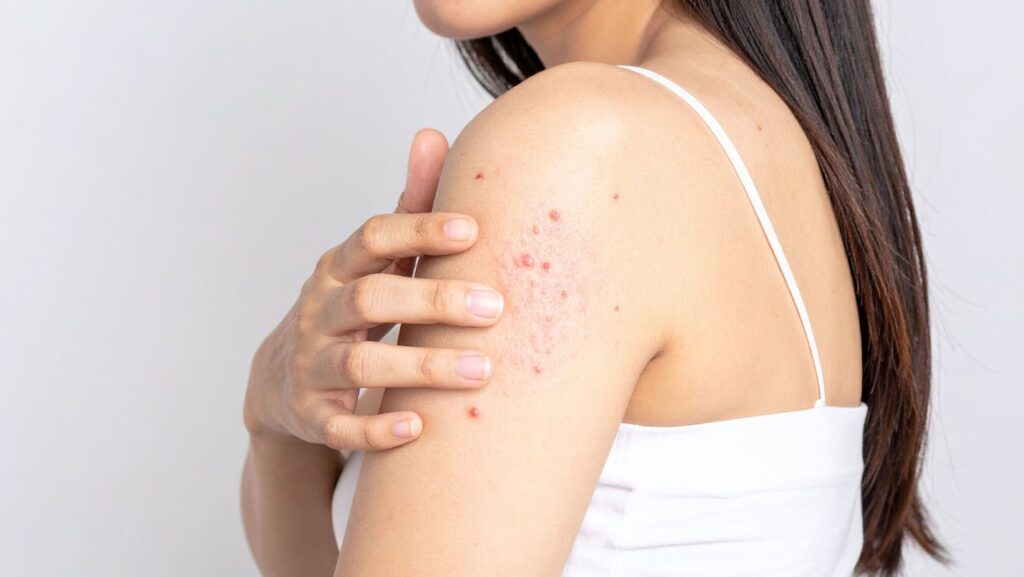Skin irritation can be uncomfortable, unsightly, and persistent, and many people look for natural remedies to manage minor issues at home. Witch hazel, a plant-based extract commonly found in toners and astringents, is often promoted for its soothing and antiseptic qualities.
But does it actually kill fungus on the skin? This guide examines what skin fungus is, the properties of witch hazel, and whether it can help treat fungal infections safely.
What is Skin Fungus?
Skin fungus refers to infections caused by fungal organisms that thrive on the outer layers of skin, nails, or hair. Common types include:
- Athlete’s Foot (Tinea Pedis): A fungal infection that affects the feet, typically causing itching, redness, and flaking.
- Ringworm (Tinea Corporis): Circular, red, and scaly patches that can appear on arms, legs, or torso.
- Nail fungus (Onychomycosis): Affects fingernails or toenails, leading to thickened, discolored, or brittle nails.
Fungal infections typically develop in warm, moist areas where skin is often exposed to sweat or friction. They can be mild and manageable, but may require treatment to prevent spreading or worsening.
Understanding Witch Hazel’s Properties
Witch hazel is an extract from the bark and leaves of the Hamamelis virginiana plant, a shrub native to North America. For centuries, it has been used as a remedy for a variety of skin ailments. It is widely available in creams, toners, and raw distilled forms. The most notable features include:
- Anti-Inflammation: Witch hazel can reduce redness, swelling, and irritation on the skin.
- Astringent: It helps tighten skin and control excess oil, which can provide relief in minor skin irritations.
- Mildly Antimicrobial: Some studies suggest witch hazel has limited antibacterial properties, though its effect on fungi is less clear.
People often use witch hazel for acne, minor cuts, insect bites, and general skin soothing. Its natural origin and low irritation risk make it an attractive option for home care.
Does Witch Hazel Kill Fungus on Skin?
While witch hazel is a powerhouse for general irritation, there is limited scientific evidence to suggest it directly kills the fungi responsible for conditions like ringworm or athlete’s foot. Its properties are not primarily antifungal, which means relying on it alone will not eliminate an infection.

That said, it can still play a supportive role in managing fungal skin issues. For instance, applying high-quality witch hazel oil can calm the discomfort caused by fungal infections, such as itching, redness, burning, and swelling. The anti-inflammatory and astringent properties help calm affected skin, tighten tissue slightly, and reduce excess moisture that fungi thrive on.
In simplest terms, witch hazel minimizes scratching and helps the skin maintain its natural barrier while you treat the infection with proper antifungal medication.
How to Safely Use Witch Hazel for Skin Irritation
Even if witch hazel doesn’t cure fungal infections, it can be used safely alongside proper antifungal treatment to manage discomfort. Just be mindful to do so safely to avoid further irritation.
First, always perform a patch test. Apply a small amount of witch hazel to a discreet area, like your inner arm, and wait 24 hours to ensure you don’t have a negative reaction. Once you know your skin tolerates it, apply it to the affected area using a clean cotton ball or pad. Gently pat the solution onto the skin; do not rub, as this can aggravate the irritation.
Remember, this is for symptomatic relief only. Witch hazel can help calm the itch and reduce redness, but it will not cure the underlying fungal infection.
When to See a Doctor
Natural remedies can help with mild irritation, but should not replace professional care for infections. Consult a doctor or dermatologist if the irritation is not improving, spreading, or worsening.
See a healthcare professional if:
- The rash spreads, becomes painful, or shows swelling.
- Nails, scalp, or large areas of skin are affected.
- You have underlying conditions such as diabetes or a weakened immune system.
These signs indicate that the infection may require more than home care. A proper diagnosis often involves a physical exam or skin sample, allowing a doctor to prescribe antifungal treatments that target the infection directly. Relying solely on self-care can let the infection persist or worsen.
Does Witch Hazel Kill Fungus on Skin? The Final Verdict
The verdict is clear: witch hazel does not kill fungus on skin. Its strength lies in providing significant relief from irritating symptoms like itching and redness. Think of witch hazel as a supportive remedy that calms your skin while a proper antifungal treatment does the heavy lifting. For a true cure, always consult a healthcare professional.



